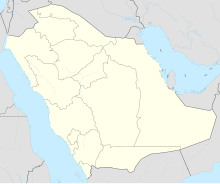Najran
Coordinates: 17 ° 30 ' N , 44 ° 8' E
Najran (also Najran , Nejran or Nagran ; Arabic نجران Nadschrān , DMG Naǧrān from old South Arabic ngrn ; formerly Abā as-Saʿūd /أبا السعود) is a city in southwestern Saudi Arabia near the Yemeni border. It is the capital of the Najran Province .
Geography and population
Najran is located in a wadi which, coming from the west, flows into the desert near Najran. Najran is one of the fastest growing cities in Saudi Arabia: its population increased from 47,500 (1974) and 90,983 (1992) to 246,880 (2004).
history
Pre-Islamic period
In ancient times , the name “Nadschran” referred to the entire oasis, the city (today the ruins of al-Uchdud ) itself was most likely called Ragmat . The Najran oasis was located in the area of settlement of the Muh'amir and at the beginning of the Incense Route , which is why their property was of great strategic importance. As early as 685 BC The Sabaean Mukarrib Karib'il Watar I conquered the Najran oasis, as did his successor Yithi'amar Bayin around 510 BC. Chr. Ragmat. In the following years , Najran seems to have fallen under Minaean and then Sabaean rule. The Roman general Aelius Gallus defeated 25 BC. The Najranites in a major battle, after Strabo it was the northern border town of Sabas at that time. In the middle of the 3rd century AD, the Najranites allied themselves with the Abyssinians , who sent them the governor SBQLM , but the Sabao-Himyar king Ilyarah Yahdib put down this revolt.
In 328 AD, Najran was the target of a campaign by the North Arabian king Imru'l-Qais bin 'Amqu. Under Abyssinian influence, a large Christian community developed in Najran, which allied itself again with the Aksumites at the beginning of the 6th century . Which for Judaism professed King Dhu Nuwas conquered Najran in 517 and caused a massacre among Christians that from now on as Martyrs of Najran were known. Sura 85 of the Koran contains, according to some interpreters, an allusion to this massacre with up to 20,000 dead.
Islamization
Around 630 a delegation of clergymen traveled from Najrān to Medina. They expressed that although they submitted to the political power of the Prophet, they did not want to convert to Islam because they saw themselves in possession of the true religion. In this historical context, the Islamic tradition puts the Koranic statement that Jesus was like Adam before God and was created just like him through the Creator's word (“Be!”) (Sura 3:59). Mohammed is said to have used this word from the Koran against the Christian clergy from Najran when there was a dispute about Jesus' sonship as claimed by Christians . Subsequently, according to the Arabic sources, he asked the clergy to bring about a divine judgment on the truth of the two religious positions by cursing each other (cf. Sura 3:61), which they refused. Finally it was agreed that the people of Najran should pay the Prophet an annual tribute of 2,000 pieces of clothing, for which the Prophet, in return, promised them protection for life and religion. The treaty about this, which is narrated in the Siyar of al-Shaibani and various works, was renewed under the caliphs Abū Bakr and Umar ibn al-Chattab .
In the year 641, however, the Christians of Najran were confronted with the accusation that they had been engaging in usury and asked to leave the city. Many of them emigrated to Iraq, where they settled near Kufa in a place they called the Najānīya. In the following period, Najran lost its importance. According to the report of Ibn Al-Mujawir , however, Jews and Christians made up two thirds of the population of Najran in the 13th century.
After the Saudi annexation
Saudi Arabia annexed Najran, which had previously belonged to Yemen, in 1934. The majority of the inhabitants of Najran are Ismailis , who to this day identify with the "martyr of Najran". In the past there have been more tensions with the Saudi government as the Ismailis feel discriminated against.
traffic
literature
- Irfan Shahîd: Art "Na dj rān" in The Encyclopaedia of Islam. New Edition Vol. VII, pp. 871b-872b.
- Hermann von Wissmann , Maria Höfner : Contributions to the historical geography of pre-Islamic South Arabia (treatises of the humanities and social science class of the Academy of Sciences and Literature in Mainz, born in 1952, no. 4). Publishing house of the Academy of Sciences and Literature in Mainz, Mainz 1953 (on ancient Nadschran: pp. 9-14)
- Hermann von Wissmann: On the history and regional studies of ancient South Arabia ( Eduard Glaser Collection , No. III = Austrian Academy of Sciences, philosophical-historical class, session reports , volume 246) Böhlaus, Vienna 1964 (on ancient Najran: pp. 147–152 , 159–206)
- Department of Antiquities and Museums: Antiquities of the Southwestern Region - Asir - Nejran , Ministry of Education, Riyadh 1975.
Individual evidence
- ↑ The Chronicle of Zuqnin, translated by Amir Harrack. Pontifical Institute of Medieval Studies, Toronto 1999, pp. 78-84
- ↑ Irfan Shahîd: The Martyrs of Najrân. New Documents. Brussels 1971
- ↑ Cf. Majid Khadduri: The Islamic Law of Nations: Shaybānī's Siyar. Baltimore: The Johns Hopkins Press 1966. pp. 278-280.
- ↑ Cf. Leone Caetani : Annali dell 'Islam . Vol. IV. Milano 1911. pp. 354-359, available online here .
- ↑ http://www.nytimes.com/2010/10/21/world/middleeast/21saudi.html?pagewanted=all&_r=0
